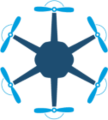Partners: UBW, SYR, ALM
In order to facilitate routine autonomous UAV operations that are not only safe but also certifiable and trusted by the public, it is critical that devices and functionality to guarantee safety are easy to explain and understand. We here provide a purely algorithmic "safety layer" that works on top of any available on-board functionality. The layer exchanges data regarding motion intention, dynamic capabilities and possible safety issues, with other vehicles and with ground-based traffic management systems, continuously verifies vehicle safety, and takes over control only to enforce very basic safety maneuvers in case of emergency or failure of critical on-board capabilities. This way, safety of the vehicle is guaranteed independently of the functioning, performance, or even the brand of many complex on-board systems such as communication units and motion planners. Instead of certifying all those systems, it suffices to certify the safety layer. Moreover, the top-level functionality of a safety layer is easily explained and demonstrated to both lawmakers and authorities. The development of the safety layer includes the design of diagnosis algorithms to verify vehicle capabilities and technical safety in real time, and of a distributed conflict detection and resolution strategy. Functionality of conflict resolution will be supported by fast and accurate motion prediction procedures, and will take advantage of hardware modules from the industrial grade UAS system developed in SC5. Vehicle capabilities will be described and shared in the form of simplified dynamic models with guaranteed uncertainty bounds, and the safety layer will also rely on a small set of basic safety manoeuvres in the form of low-level motion controllers. UBW will create and provide a UAV lab that permits experimental tests of scenarios with high airspace density. The goal is to experimentally demonstrate safe autonomous operation of several independent UAVs in densely populated airspace, under laboratory conditions. Failure of on-board components such as detection, communication and planning systems will certainly degrade performance, but must not impair safety due to a functioning safety layer. Dependence of performance degradation on particular failures and on airspace density will also be evaluated. Hazard analysis and risk assessments on particular identified failure modes will be performed to address regulatory requirements to support multi-UAV scenarios.






